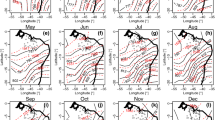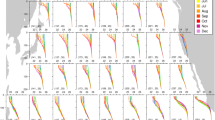Abstract
The results of investigations of the structure and dynamics of the atmospheric planetary boundary layer in the transitional “ocean-continent” zone in the winter period, restored from the remote lidar soundings, are given. The characteristic parameters of PBL are ascertained, as well as ways of formation of its structure and dynamics. The distinctive features of PBL for a given region are shown by the examples of December 13 and 14, 2011. The mean PBL height, upper boundary of the convective layer, and the mean height of the stable layer in January and February are presented. The fact is grounded that the well-developed convection observed at nighttime is caused by existence of a low-level jet stream and high cooling altitudes of the planetary boundary layer.
Similar content being viewed by others
References
Yu. S. Balin, A. D. Ershov, and I. E. Penner, “Shipborne Lidar Investigations of Aerosol Fields in the Atmosphere over Lake Baikal. Part 1. Longitudinal Sections,” Atmos. Ocean. Opt. 16(5–6), 402–410 (2003).
Yu. S. Balin, A. D. Ershov, and I. E. Penner, “Shipborne Lidar Investigations of Aerosol Fields in the Atmosphere over Lake Baikal. Part 2. Cross Sections,” Atmos. Ocean. Opt. 16(7), 541–551 (2003).
V. A. Kovalev, Elastic Lidar: Theory, Practice and Analysis Metods (Wiley-Interscience, New Jersey, 2004).
V. Santacesaria, F. Marenco, D. Balis, A. Papayannis, and C. Zerefos, “Lidar Observations of the Planetary Boundary Layer above the City of Thessaloniki, Greece,” Il Nuovo Cimento C 21(6), 585–595 (1998).
R. B. Stull, An Introduction to Boundary Layer Meteorology (Kluwer Academic Publishers, Dordrecht; Boston; London, 1988).
J. H. Sorensen, A. Rasmussen, and H. Svensmark, “Forecast of Atmospheric Boundary Layer Height Utilized for ETEX Real-Time Dispersion Modelling,” Phys. Chem. Earth 21(1996).
R. Endlich, E. Ludwig, and E. Uthe, “An Automatic Method for Determining the Mixed Depth from Lidar Observations,” Atmos. Environ. 13(1979).
C. Flamant, J. Pelon, P. H. Flamant, and P. Durand, “Lidar Determination of the Entrainment Zone Thickness at the Top of the Unstable Marine Atmospheric Boundary Layer,” Boundary-Layer Meteorol. 83(2), 247–284 (1997).
K. L. Hayden, K. G. Anlauf, R. M. Hoff, J. W. Strapp, J. W. Bottenheim, H. A. Wiebe, F. A. Froude, J. B. Martin, D. G. Steyn, and I. G. McKendry, “The Vertical Chemical and Meteorological Structure of the Boundary Layer in the Lower Fraser Valley during Pacific 93,” J. Atmos. Environ. 31(14), 2089–2105 (1997).
S. V. Samoilova, Yu. S. Balin, G. P. Kokhanenko, and I. E. Penner, “Investigation of the Optical Distribution of Tropospheric Aerosol Layers from Multifrequency Laser Sensing Data. Part 2: The Vertical Distribution of Optical Aerosol Characteristics in the Visible Region,” Atmos. Ocean. Opt. 23(2), 95–105 (2010).
M. Sicard, C. Pérez, F. Rocadenbosch, J. M. Baldasano, and D. García-Vizcaino, “Mixed-Layer Depth Determination in the Barcelona Coastal Area from Regular Lidar Measurements: Methods, Results and Limitations,” Boundary-Layer Meteorol. 119(1), 135–157 (2006).
L. Menut, C. Flamant, J. Pelon, and P. H. Flamant, “Urban Boundary-Layer Height Determination from Lidar Measurements over the Paris Area,” Appl. Opt. 38(6), 945–954 (1999).
W. P. Hooper and E. W. Eloranta, “Lidar Measurements of Wind in the Planetary Boundary Layer: The Method, Accuracy and Results from Joint Measurements with Radiosonde and Kytoon,” J. Appl. Meteorol. 25(7), 990–1001 (1986).
A. K. Piironen and E. W. Eloranta, “Convective Boundary Layer Mean Depths, Cloud Base Altitudes, Cloud Top Altitudes, Cloud Coverages, and Cloud Shadows Obtained from Volume Imaging Lidar Data,” J. Geophys. Res., D 100(12), 25569–25576 (1995).
Atmosphere Aerosol and Ozone Monitoring in CIS Region through Lidar Network (CIS-LiNet) Final Project Technical Report, ISTC Project no. B-1063.
N. A. Dashko, Course on Synoptical Meteorology (Far Eastern State University, Vladivostok, 2005) [in Russian].
T. Sakai, T. Nagai, M. Nakazato, Y. Mano, and T. Matsumura, “Ice Clouds and Asian Dust Studied with Lidar Measurements of Particle Extinction-to-Backscatter Ratio, Particle Depolarization, and Water-Vapor Mixing Ratio over Tsukuba,” Appl. Opt. 42(36), 7103–7116 (2003).
Z. Liu, N. Sugimoto, and T. Murayama, “Extinction-to-Backscatter Ratio of Asian Dust Observed with High-Spectral-Resolution Lidar and Raman Lidar,” Appl. Opt. 41(15), 2760–2767 (2002).
S.-W. Kim, M.-H. Kim, S.-C. Yoon, and N. Sugimoto, “Extinction-to-Backscatter Ratio of Asian Dust Observed with a Combined Raman Elastic-Bakscatter Lidar in Seul, Korea,” in Goldschmidt 2011, Prague, Czech Republic, August 14–19, 2011.
L. Su and O. B. Toon, “Saharan and Asian Dust: Similarities and Differences Determined by CALIPSO, AERONET, and a Coupled Climate-Aerosol Microphysical Model,” Atmos. Chem. Phys. 11(7), 3263–3280 (2011).
H. Wei, R. Koga, K. Iokibe, O. Wada, and Y. Toyota, “Depolarization Properties of Asian Dust (KOSA) Measured by LIDAR in Okayama in the Spring of 1998,” Memoirs of the Faculty of Engineering, Okayama University 34(1, 2), 27–37 (2000).
W. N. Chen, F. J. Tsai, C. K. Chou, S. Y. Chang, T. K. Chen, and J.-P. Chen, “Optical Properties of Asian Dust Measured by Raman Lidar at Taipei, Taiwan,” in Proc. of the 23rd International Laser Radar Conference (ILRC23), July 24–28, 2006, Nara City, Japan.
Y. Iwasaka, G.-Y. Shi, Y. S. Kim, A. Matsuki, D. Trochkine, D. Zhang, M. Yamada, T. Nagatani, M. Nagatani, and Z. Shen, “Pool of Dust Particles over the Asian Continent: Balloon-Borne Optical Particle Counter and Ground-Based lidar Measurements at Dunhuang, China,” Environ. Monit. and Assess. 92(1–3), 5–24 (2004).
Author information
Authors and Affiliations
Additional information
Original Russian Text © O.A. Bukin, Yu.N. Kulchin, A.N. Pavlov, S.Yu. Stolyarchuk, K.A. Shmirko, 2013, published in Optica Atmosfery i Okeana.
Rights and permissions
About this article
Cite this article
Bukin, O.A., Kulchin, Y.N., Pavlov, A.N. et al. Characteristics of structure and dynamics of the planetary boundary layer in the transitional “ocean-continent” zone. Part 1. Winter period. Atmos Ocean Opt 26, 60–67 (2013). https://doi.org/10.1134/S1024856013010053
Received:
Published:
Issue Date:
DOI: https://doi.org/10.1134/S1024856013010053




